
The study asserts that metalled forest roads at lower elevations and closer to the forest periphery have greater detrimental effects on surrounding ecosystems than unmetalled forest roads.
Authors
Girish Agrawala, Professor, Jindal School of Art & Architecture, O.P. Jindal Global University, Sonipat, Haryana, India.
Deepika Mann, Department of Civil Engineering, Shiv Nadar University, Dadri, Uttar Pradesh, India.
P.K. Joshi, School of Environmental Sciences, Jawaharlal Nehru University, New Delhi, India; Special Centre for Disaster Research, Jawaharlal Nehru University, New Delhi, India.
Summary
Global road network has expanded at an unprecedented rate in the last century, and is needed for economic and social growth. However, the road networks through forest landscapes open it up for further exploitation and act as permanent scars on these fragile ecosystems.
This has driven greater interest in studying ecological impacts of the road networks on forest cover dynamics. Our study assessed changes in forest canopy density (FCD) using satellite-based indices, and forest fragmentation using Morphological Spatial Pattern Analysis (MSPA) for 2000 and 2016 in the Central Himalaya.
The analysis reports reduction in areas with high FCD from 85% of geographical area in 2000 to 76% in 2016. Specific to road sites, maximum change has taken place owing to expansion of national highway (NH) 72 from two-lane in 2000 to four-lane in 2016.
MSPA results also support this argument as forest fragmentation has substantially increased along the road transects, especially NHs and metalled roads. The study asserts that metalled forest roads at lower elevations and closer to the forest periphery have greater detrimental effects on surrounding ecosystems than unmetalled forest roads.
Reason being continuous disturbance due to heavy traffic load, ease of accessibility to forest and added anthropogenic disturbances near the periphery. As ecological impacts of road network have not been mainstreamed into research and policy making in Himalaya, the findings from this study shall improve knowledge on the current status and potential future pathways of sustainable infrastructure development in Himalaya in particular and mountains around the globe in general.
Published in: Ecological Engineering
To read the full article, please click here.


